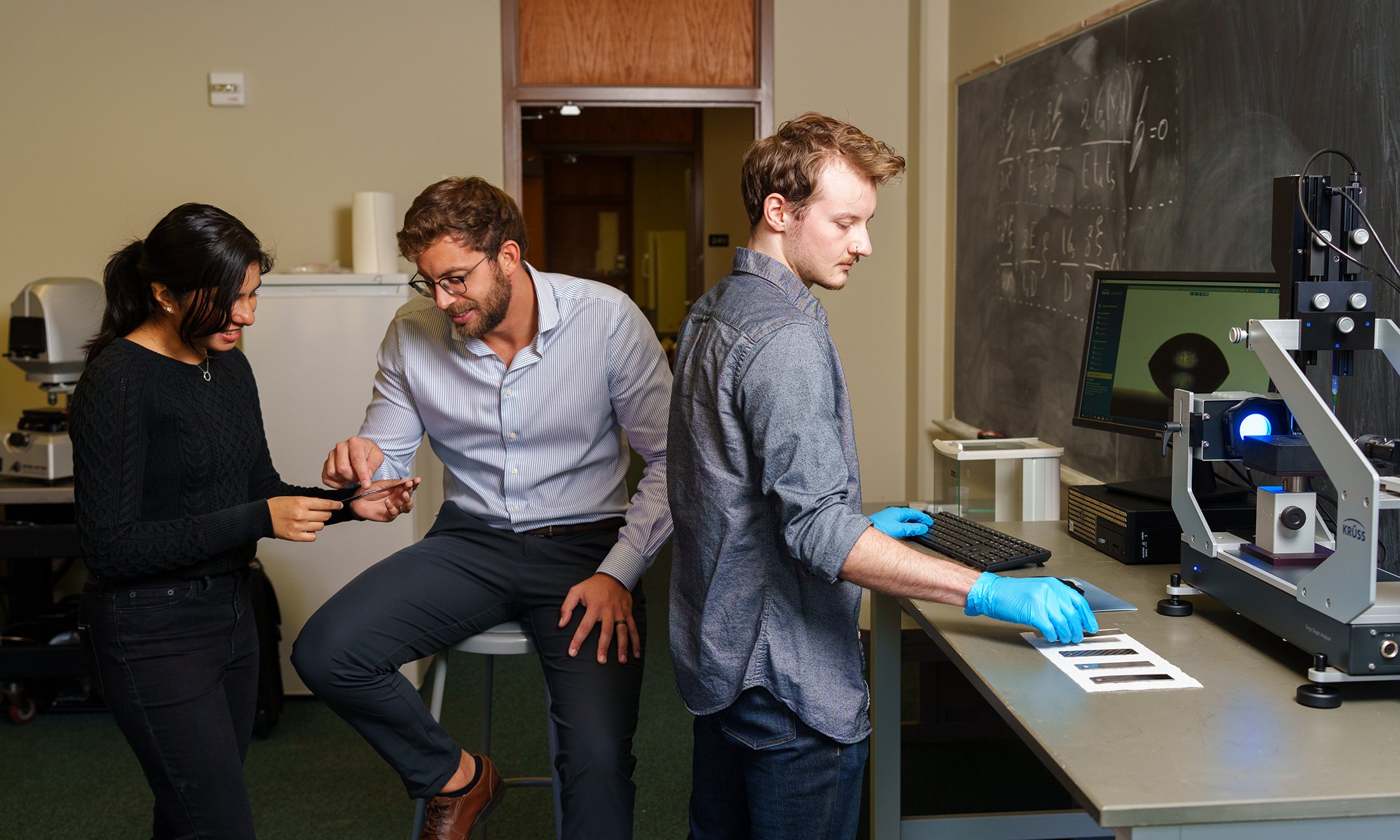Reversible Future
Marco Gerini-Romagnoli, Ph.D., investigates de-bondable and reversible adhesives to facilitate part replacement, repair, and end-of-life (EoL) recycling.
For millennia humankind has liberally used Earth’s natural resources. As the world stands today, however, it faces an enormous challenge to fundamentally change the ways things are done in response to the urgent need for a more sustainable global economy. Across various industries, science is paving a way to a vast array of such changes. At OU, Marco Gerini-Romagnoli, Ph.D., assistant professor of mechanical engineering (ME), investigates de-bondable and reversible adhesives to facilitate part replacement, repair, and end-of-life (EoL) recycling.
In the case of many manufacturing industries, the direction of essential changes is to make structural components lighter, to move to fewer components, and to design for disassembly, which will facilitate EoL and make positive moves towards a circular economy.
“Strength, stiffness, and durability improvements as well as design flexibility considerations fuel adhesive bonding’s growing popularity in structural applications. However, bonded joints can hinder repair or EoL recycling activities for complex multi-material structures, or at least make the process very labor- and time-intensive. Parts can get damaged during disassembly, or it can be problematic to separate materials for EoL. De-bonding on demand technologies, theoretically, allow to overcome these limitations, but they are still largely in development,” explains Dr. Gerini-Romagnoli, whose focus is on the implementation of reversible adhesive technologies for structural composite joints.
One of the ways to induce substrate separation is through additives that can weaken the adhesive layer upon activation. Utilizing the OU’s Fastening and Joining Research Institute site (FAJRI), one of the few academic research facilities in the world that is solely dedicated to material joining, a collaborative group of researchers, which also includes Sayed Nassar, Ph.D. (ME), Roman Dembinski, Ph.D. (Department of Chemistry), and Dr. Gerini-Romagnoli’s student Khushboo Tedlapu, conducted a number of studies to advance de-bonding technologies.
In the initial experiment, the focus was on joints with at least one metallic substrate. Thermally Expandable Particles (TEPs) were added to a structural adhesive, Betamate 73326/73327M (a two-part epoxy) to achieve the reversibility of Single Lap Joints (SLJ). The team evaluated the impact of environmental aging on the static, fatigue, and de-bonding performance of these SLJs. Specifically, the parameters used to study the reversibility performance were the joint debonding time and the substrate temperature during debonding.
This study showed that the joint strength and the de-bonding action of the TEP additives were insensitive to environmental aging.
“Bond reversibility was possible for additive concentrations larger than 5% wt., and time and temperature to de-bond decreased with increasing particles content,” says Dr. Gerini-Romagnoli.
The team also worked on improving de-bonding performance with non-metallic joint substrates, such as fiber reinforced composites. Embedding ferromagnetic inserts in the bondline significantly decreased de-bonding time and temperature. The design of the inserts was optimized iteratively, and the modified joints showed concurrent improvements in lap shear strength (up to 10% from baseline) and TEP activation time (up to two times shorter).
Currently, the FAJRI group is in the beginning stages of working with vitrimers - a new class of polymers that can de-crosslink. In all traditional thermoset structural adhesives, long polymeric chains are crosslinked during the curing process, creating a strong 3-dimensional network. Cross-linking gives thermoset adhesives their strength and increases their Glass Transition Temperature, often turning them from a paste into a solid. However, the cross-linking bonds in thermoset polymers are not reversible.
“Epoxy-based vitrimers represent a promising option toward sustainability and circular economy in many structural applications. They are derived from thermoset polymers, but what sets them apart is their reversible covalent bonds. In practical terms, this means that a vitrimer-based adhesive can be reshaped, reformed, de-bonded, and reused, opening up exciting possibilities for recycling and repair, especially in defense, infrastructure, automotive, and aerospace industries,” says Khushboo Tedlapu, who is pursuing a master’s degree in mechanical engineering.
“There have been a couple of early studies published this year on using vitrimers as adhesives, so we are not the first ones, but it's still a technology in its infancy. The expectation is that once we will optimize formulation and application, we will be able to re-bond de-bonded joints,” adds Dr. Gerini-Romagnoli.
Another aspect of Dr. Gerini-Romagnoli’s research is Non-Destructive Inspection (NDI) of composite adhesive joints, conducted along with Lianxiang Yang, Ph.D., distinguished professor of mechanical engineering. Due to the inherent material discontinuities in the matrix of composite materials, NDI of bonded joints can be challenging. The scientists are investigating synergistic integration of optical techniques with mechanical modeling to detect void-type defects in the adhesive layer.
Regardless of the joining method, material interfaces are complex and vulnerable regions. Developing a reversible adhesive that can de-bond on-command is an important step in aiding repair and recyclability. Dr. Gerini-Romagnoli’s material joining research, which also involves bolted joints, is supported by the NSF IUCRC (Industry-University Cooperative Research Center) for Composite and Hybrid Materials Interfacing (CHMI), where he serves as an OU site manager. For more information, email [email protected].

 December 20, 2023
December 20, 2023
 By Arina Bokas
By Arina Bokas



